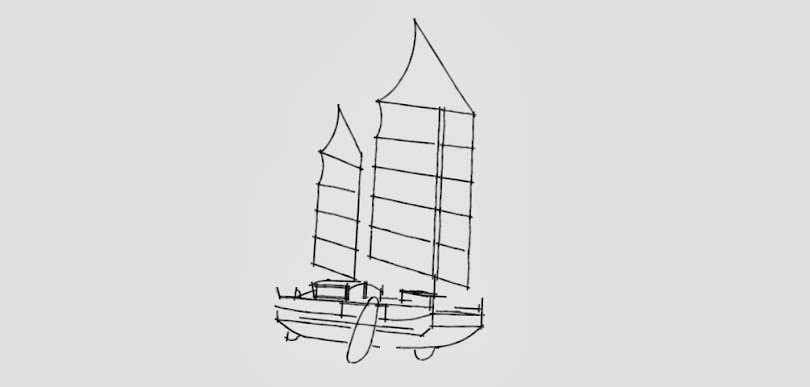 |
| Cross Sections of Arced and Flat PFP Construction |
The light is what guides you home, the warmth is what keeps you there.
~Ellie Rodriguez
Ply Foam, Ply! Looking at Insulation
Over the years, we've come to value insulation.
Not so much to keep us warm - seems simple plywood sides, a good wood stove, long johns and sweaters are plenty for our personal comfort - but to keep condensation at bay.
Condensation occurs when warm, humid air encounters a surface which is cold, relative to the air. Thinnish, dense materials such as plywood radiate their heat away to the outer world, and provide just the kind of surface that encourages condensation. In the cool, moist climes of the Pacific Northwest, condensation is a constant companion.
And where condensation is like irrigating the spore farm to encourage crop after crop of mildew.
Good ventilation and techniques to draw moisture from the air help, but every time the hatches open in damp weather, we refresh our moisty atmosphere. For best results, these must be backed up by insulation.
Insulation slows the conduction of heat from the interior. This means less fuel to achieve the same internal temperatures. It also means the inboard surface of insulated walls and windows stays close to the internal ambient. Humidity remains as vapor in the air, where it belongs.
Mildew and airflows play a part, too, in our decision as to how we insulate.
Insulation can be made removeable. This is cheap, quick and dirty. I'm immediately drawn to it!
One friend used foamboard cut to shape, then coated with vinyl wallpaper. The vinyl is attractive, easy to clean and removable for cleaning behind / inspection.
Another used mylarized bubblewrap sheet insulation, simply hung along the walls. The effect was surprisingly cozy, and a lit his cabin up from every direction.
In A Warm Dry Boat by Roger McAfee, he suggests hollow walls with inexpensive fiberglass batting, and conducted some shake-it-up tests that sound promising.
The problem with all these, for us, is that that humid air can flow into all of these, more or less unimpeded, merely condensing out of sight. Mildew or worse, black mold, can happily multiply until spring cleaning rolls around.
Or if one DOES impede airflow, then dryrot - another major foe - lies in wait.
I've torn enough stuff apart, around here, to have seen how nasty, fungal flows love to work into any un-bonded space, however diminutive.
A friend introduced us to SIP (Structural Insulated Panel) construction, aka PFP (ply-foam-ply) construction. In this method, foamboard is laminated between two sheets of plywood, forming a composite devoid of airways.
There are even fringe benifits: A PFP composite is, itself, a girder, increasing rigidity and strength. And foamboard contributes substantially toward positive buoyancy.
Since much of the framing will be dimensional, 2x stock, 1 1/2in foamboard is convenient. Total R-value comes to about 8.
We've considered three general approaches:
- Build the sides as a single SIP - This offers several advantages, chief among which is the ability to assemble, sheath and finish on-the-bench. But also some big drawbacks. The decisive one, for us is that each side gets to be heavier than we can handle without considerable, mechanical ingenuity.
- Assemble the sides from SIPped panels - This makes each sub-panel manageable, at the cost of some of the finishing advantages. Construction is complicated by framing which runs the length of the boat, spanning multiple panels... it's possible to assemble, but tricky to get right.
- Retrofit insulation and inboard face - This makes for vertical, tedious, but straightforward assembly, with easy-to-handle parts. It eliminates butts on the inner face. Cleats for furnishings mostly double as framing for foam and inner face, and can be lighter where not. Unlike preceding methods, it puts the heavy skin outboard, where I like it.
It's economical of materials, as one can be (easily) selective as to what to insulate and what not. We can mix-and-match, with inexpensive doorskin (1/8in plywood, used for hollow door construction) inside cabinetry, and 1/4 inch elsewhere, where we might want to fasten lightly into the wall. Or FRP (Fiberglass Reenforced Plastic) panel in the galley, for easy wipe-down. It takes special glue, but may be worth it.
So it looks like number three for us.
We'll be insulating the entire interior this time, including holds (unlike SLACKTIDE). We found that even the holds condense. The forward achor well seems to be the only exception... it may condense as well, but very little, and has a high salt content.
So, having waffled away at this for weeks it looks like the following:
- 3/4in ACX outer face
- 1 1/2in foamboard + 2x framing of western red cedar
- 1/8in mahogony doorskin and 1/4in ACX
- Waterbased contact glue for foamboard faces with Gorilla Glue around edges (gap-filling)
So, until further notice, that's the plan!






.JPG)
.JPG)
.JPG)
.JPG)
.JPG)
